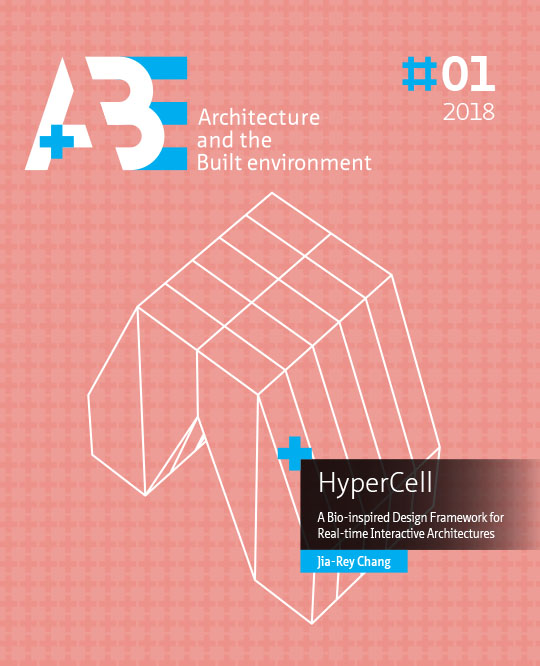HyperCell
A Bio‑inspired Design Framework for Real-time Interactive Architectures
DOI:
https://doi.org/10.7480/abe.2018.1.3753Abstract
This research believes that understanding the relationship between Interactive Architecture and the principles of biology will become a mainstream research area in future architectural design. Aiming towards achieving the goal of “making architecture as organic bodies”, almost all the current digital techniques in architectural design are executed using computational simulation: digital fabrication technologies and physical computing. Based on its’ main biological inspirations, Evolutionary Development Biology (Evo-Devo), this research intends to propose a novel bio-inspired design thinking wherein architecture should become analogs to the growing process of living organisms (Figure 6.1). Instead of being born from static optimization results most of the architecture seems content at aiming for nowadays, this research is looking towards designing dynamic architectural bodies which can adapt to the constantly changing environments and are thus seeking optimization in real-time. In other words, architecture should come “alive” as a living creature in order to actively optimize itself with respect to dynamic environmental conditions and user behavior’ requirements in real-time. Following the notion of “architecture as organic bodies”, six major topics were derived from the publication of “New Wombs: Electric Bodies and Architectural Disorders” (Palumbo, 2000). These topics are aimed at initiating critical discussions between body and space, which, are used here to re-interpret six main traits of being an interactive architecture: Dis-measurement, Uprooting, Fluidity, Visceral Nature, Virtuality, and Sensitivity. These six topics merge diverse key points from aforementioned chapters including outlining the vision of active interacting architecture, the transformation of human bodies under digital culture, the profound biological inspiration from Evo-Devo and the fundamental componential notion of swarm, which leads to the ultimate notion of embodying organic body-like interactive Bio-architecture.
Dis-measurement: Acknowledging the premise of “architecture (technology) as an extension of human bodies” proposed by Marshall McLuhan (McLuhan, Understanding Media: The Extensions of Man, 1964), it is, still difficult to explicitly define the boundary of a space, especially in the context of a borderless cyberspace (the Internet). Space in such a context expands more than ever before and thus makes traditional measurements techniques unfeasible. With cyberspace, people can be virtually present in different places at the same time, thus breaking existing physical boundaries of a space. From another point of view, space as an extension of our bodies constantly adapting to environmental conditions and user demands, creates an intimate linkage between physical bodies and spatial bodies. Interaction in such instances can be seen from a micro-scale: between biological cells and intelligent architectural components to the macro-scale: between physical organic bodies and spatial bodies/architectural space.
Uprooting: Apart from further extending the “Dis-measurement” idea by directly plugging into cyberspace (the Internet), “Uprooting” is also interpreted as adaptation devoid of any site/location constraints. In other words, the idea of “Uprooting” implies, generating an architecture that can adjust/modify in accordance with its existing surroundings by interactions between its smallest intelligent components like cells in a body searching for dynamic equilibrium. In this case, architecture has no particular reason to be designed as “rooted” on sites.
Fluidity: With the neural system inside the body, most of the messages can be transmitted, received and sent within less than a millionth of a second. To envision architecture as an information processor, which has abilities to react to dynamic environmental conditions and user demands, efficient information protocols must be built into such an organic architectural body to create seamless exterior/interior transformations.
Visceral Nature: Visceral can be interpreted in the form of an embodied organ. This implies envisioning architecture in the form of a living-entity. It is no longer the case of mimicking a natural form and thus claiming a building to be organic, but rather instigates one to look deeper into the principles of a natural form’s morphogenesis and apply these to generate a truly organic space. Through the study of Evo-Devo, several principles will be applied to generate an interactive organic Bio-architecture. It is thus not an organic looking shape that matters, but the principles behind the shape, which matter. For instance, principles of self-organization, self-assembly, and self-adaptation, providing possibilities of making body-like architectures with multi-directional and multi-modal communications both inside out and outside in. An intelligent architecture, should “live” in the environment just as how the body lives with its’ Visceral Nature.
Virtuality: It is impossible to talk about physical space without mentioning virtual space nowadays. From cyberspace, augmented reality to virtual reality, “Virtuality” is related to “interaction” since the beginning and has gradually become an inevitable aspect of our daily lives. In fact, virtual space has to still use constraints from the physical world to enhance experiential aspects. The ultimate goal of virtual reality here is not to end up with a VR helmet and keep constantly being stimulated by electronic messages, but to bring the physical to the virtual and in the process, attempt to search for a dynamic balance between the virtual and real by merging them together. With the assistance of virtual reality, novel unrealistic space can still be realized into creative tangible immersive and fascinating spaces, which, earlier was not possible.
Sensitivity: The notion of “architecture is an extension of human bodies”, is crucial to embrace, if we consider enhancing the sensing abilities of the space as a body not only externally but also internally. In a digital space, active sensing can be achieved by attaching specific devices. In an interactive space, like an organic body, the sensing capabilities of the space have to be fast, accurate, intuitive, and predictive. The sensing system should thus not only work externally to sense the surrounding environment but also internally in order to fulfill the users’ demands in time. With such a connection between human bodies and spatial bodies, it should become relatively understandable for the space to know the requirements of the users by means of hand gestures instead of verbal cues. The sensitivity, in this case, should rely on local information distribution as a bottom-up system rather than a top-down centralized demanding structure.


